The most prominent feature in Berlin was the protruding and authentic street art. Since the construction of the Berlin Wall in August 1961; the city became saturated with creative art pieces in both blatant and unusual locations. Graffiti art in Berlin is a huge part of the city’s history and attracts a vast number of tourists all year round. During the visit, one area of Berlin particularly caught my attention; the open-air, East Side Gallery with its insane art pieces of various meaning.
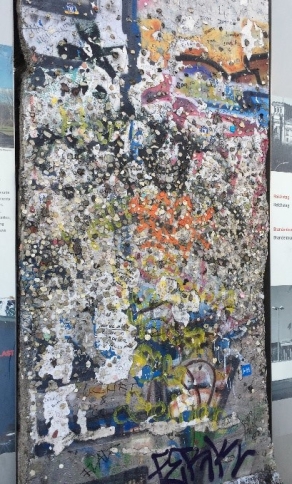
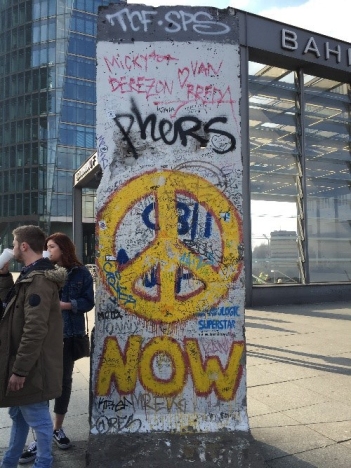
Sections of the Berlin Wall. (Mitchell, 2018).
Berlin has become a canvas for political, cultural and independent graffiti art since the fall of the Berlin Wall on the 9th November 1989. In 1990, artists from over 20 countries produced art pieces in elation of Germany’s reunification (Marisol, P, L, 2015). The East Side Gallery combines both modern and resistance art pieces with the menacing evidence of the Berlin Wall that once separated West Berlin from the communist East.
There are both positive and negative connotations surrounding graffiti in Berlin. Art is extremely subjective (Robert, 2012); many tourists wander along the East Side Gallery posing for MANY pictures against the creative backdrop without fully understanding the imaginative meaning of the artistic pieces along the mile stretch (and yes, we obviously followed suit). Academic geographers such as Smith (2000: 86) argue that the graffiti creates a sense of unrest and criminality; it often suggests a lack of control. Some believe that graffiti undermines authoritarian power (Rose, 1994). Focusing on the East Side Gallery and in opposition to both Rose (2000) and Smith (2000), there are themes of unification, hope and the discouragement of war along the modernised wall (BBC News, 2009). This is evident through various creations e.g. the ‘Fraternal Kiss.’
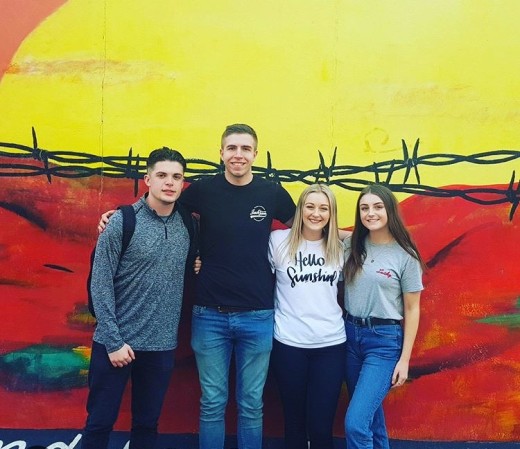
Touristic Opportunities at the East-Side Gallery. (Mitchell, 2018).
The piece posed on the East Side Gallery named ‘My God, Help Me to Survive This Deadly Love’ also known as the ‘Fraternal Kiss’ is one of the most iconic pieces of art in Berlin. What does it show? Why are they kissing? Well, the ‘Kiss’ shows Soviet leader Leonid Brezhnev giving the East German President Erich Honecker a passionate kiss- at first glance, many believe the painting to be a joke, however the art is based on a photograph taken at the 30th anniversary of the GDR (Peterson, 2012).
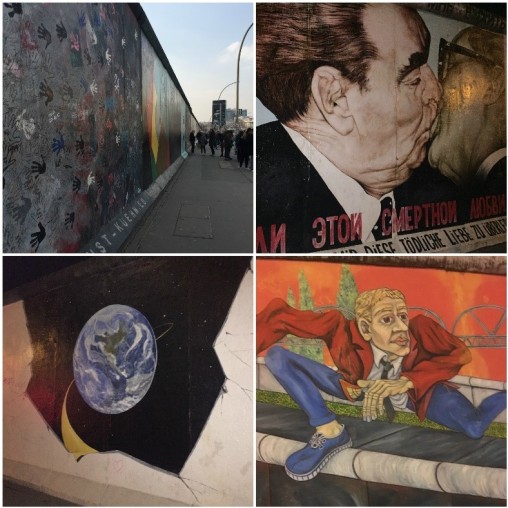
Collage of photographs taken of the East-Side Gallery art pieces. (Mitchell, 2018).
As Berlin has become a more popular destination for tourists in recent years, the commodification and touristification of some areas of the city have evolved. Locations such as Checkpoint Charlie, The Brandenburg Gate and parts of the Berlin Wall are bustling with visitors and obviously, businesses take every opportunity to create a heavy income through museums, food trucks, merchandise stalls etc.
Soundscapes within geography are currently emerging; they provide an additional sense when understanding the meanings and representations of an area or location (Arun, 2009). The East Side Gallery is a free attraction in Berlin and so the area can be extremely busy. Throughout the daytime the East Side Gallery is booming; it is situated next to a main road and the tourists create a soundscape that represents a thriving, popular and well-known area. In the evening, however, the East Side Gallery drastically changes; it becomes a quiet, peaceful area with the occasional passer-by. The serenity in the evening allows you to truly imagine how Berlin used to be before the wall was deconstructed.
Although the East Side Gallery is comprised of numerous art pieces, many of the paintings are now covered in tagging by tourists and resistance movements. Many of the tourists feel they want to leave a mark on the former ‘Iron Curtain,’ even though there are many small signs along the 1.3km stretch stating that defacing the wall is forbidden (Connolly, 2015). I noticed many small signatures on the wall as I strolled along the East Side Gallery (as shown below); many stated a name and their home country or city, some were relatively rude, and some tried to resist the paintings- these tourists are known as ‘woodpeckers’ (Connolly, 2015). There are plans to place a fence in front of the Berlin Wall to stop ‘woodpeckers’ scribbling on the paintings (Connolly, 2015) however, as a preventative, I’m unsure that this will discourage the ‘woodpeckers’- tourists can be extremely determined when it comes to making their mark!
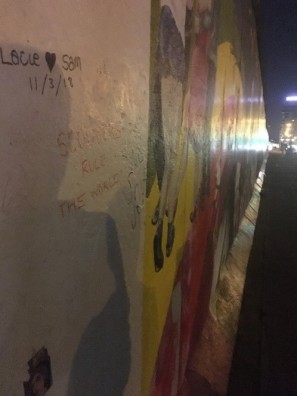
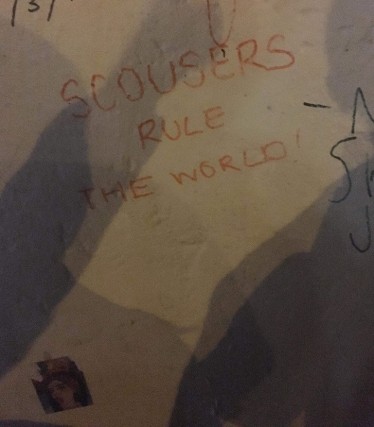
Tagging on the Berlin Wall. (Mitchell, 2018).
Berlin was such an interesting and unique city. The connotations I had created of the street art before visiting Berlin was of low-quality tagging; scribbles and small signatures of tourists that had passed through the area making their mark. However, the East Side Gallery and many other murals across the city transformed this stereotypical representation into amazement and endearment. The detailed street art provides a sense of independence and produces a creative identity for the contemporary city of Berlin.
Suggested Further Reading and References:
Arun, S. (2009). Soundscapes. In: Kitchin, R and Thrift, N. (2009). International Encyclopaedia of Human Geography. Elsevier: Amsterdam. Pp 236-240.
BBC News. (2009). Bid to Rescue Berlin Wall artwork. [Online]. Available at: http://news.bbc.co.uk/1/hi/world/europe/7674135.stm [Last Accessed: 9th April 2018].
Connolly, K. (2015). Berlin plans fence to protect wall from souvenir hunters. The Guardian. [Online]. Available at: https://www.theguardian.com/world/2015/nov/05/berlin-plans-a-fence-to-protect-wall-murals-from-souvenir-hunters . [Last Accessed: 9th April 2018].
Marisol, P, L. (2015). The Murals on Berlin Wall’s East Side Gallery. Travelling Soulmates. [Online]. Available at: http://www.travelingsolemates.com/the-murals-on-berlin-walls-east-side-gallery/ [Last Accessed: 9th April 2018].
Peterson, D. (2012). The Kiss. Why is Brezhnev Kissing Honecker on The Berlin Wall? [Online]. Available at: http://www.disappearingman.com/berlin-wall/the-kiss/ [Last Accessed: 9th April 2018].
Robert, N. (2012). Berlin Street Art- Graffiti Has ‘Destroyed’ A Great German City. Welcome to Yomadic. [Online]. Available at: https://yomadic.com/berlin-street-art/ [Last Accessed: 9th April 2018].
Rose, T. (1994). Black Noise: Rap Music and Black Culture in Contemporary America. American Music. Vol 14. Issue 2. Pp 231-233.
Smith, S. (2000). Graffiti. In: Pile, S and Thrift, N. (2000). City A-Z. Routledge: Oxon.